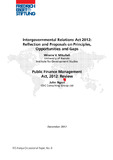| dc.description.abstract | Intergovernmental relation is an important principle in realising synergy among different levels of
government and within specific levels for stability of entire government. It applies irrespective of the
system of government embraced by a country since there is always the state and its related agency
the government. For governments to work efficiently there has to be further decentralisation
with lower levels of government taking central role in implementation of policies through various
programmes. Although decentralisation, in particular its devolution aspect has been challenging
to effectively realise, many countries have opted for some form of decentralisation aimed at
ensuring efficient provision of services.
For many years Kenya embraced the deconcentration form of decentralisation which did not give
full powers to local governments. Decision making was largely done at the centre with the Local
Authorities (LAs) not having a free hand to formulate policies and laws relevant for managing
their jurisdictions. Critiques of this model attributed the poor record of local development to the
strong hand of central government, and advocated during the Constitution making for devolution
of powers to the lower levels of government. This was achieved through the promulgation of the
Kenya Constitution in August 2010. This, notwithstanding, more work remained to be done in
terms of enacting relevant laws for full realisation of the devolution aspect of the Constitution. To
achieve this, a Task Force was constituted to come up with a report, policy and propose relevant
Acts of Parliament for operationalisation of devolution. It is this process enabled by various
government agencies and the Parliament that produced the Intergovernmental Relations (IGR)
Act, 2012.
The IGR Act 2012 is Kenya’s mechanisms for ensuring smooth operation between the two levels of
government, National and County created by the Constitution of Kenya. Whereas there are many
provisions in the Constitution that inform the IGR, Article 6 (2) is particularly crucial. The Article
provides for two levels of governments at the national and county levels. The provision notes that
the `governments are distinct and inter-dependent and shall conduct their mutual relations on
the basis of consultation and cooperation’. These are not unique caveats to Kenya. They prevail
in other jurisdictions which have embraced higher forms of decentralisation such as USA, South
Africa and Nigeria. Apart from this introduction, this paper reviews the IGR Act of Kenya, 2012 by
first providing a conceptual understanding of intergovernmental relations followed by presentation
and discussion of the provisions of the IGR Act, 2012, including opportunities and gaps. | en |

